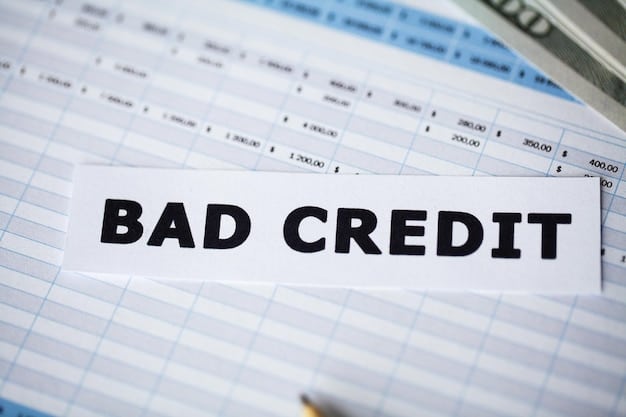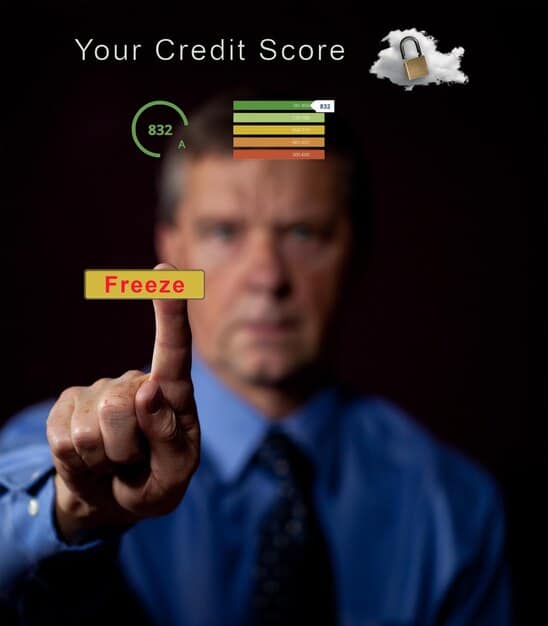Understanding Your Credit Report: A Guide to Error Correction

Understanding your credit report involves knowing how to access it, identify inaccuracies, and take steps to correct them to maintain a healthy credit score and financial well-being.
Understanding your credit report: a comprehensive guide to identifying and correcting errors is crucial for maintaining good financial health. Your credit report is a detailed record of your credit history, and any inaccuracies can negatively impact your ability to secure loans, rent an apartment, or even get a job. This guide will walk you through understanding your credit report, spotting errors, and taking the necessary steps to correct them.
What is a Credit Report and Why is it Important?
A credit report is a detailed summary of your credit history. It includes information about your payment history, outstanding debts, credit accounts, and any public records like bankruptcies. Credit reports are used by lenders, landlords, and employers to assess your creditworthiness and make decisions about whether to extend credit, rent a property, or offer employment.
Understanding the contents of your credit report and its importance is the first step toward financial health. A good credit report can result in lower interest rates on loans, better insurance premiums, and more favorable terms for financial products.
Key Components of a Credit Report
A credit report typically includes the following sections:
- Personal Information: Your name, address, Social Security number, and date of birth.
- Credit Accounts: Details about your credit cards, loans, and other credit lines, including account numbers, credit limits, balances, and payment history.
- Public Records: Information about bankruptcies, tax liens, and civil judgments.
- Credit Inquiries: A list of entities that have accessed your credit report, including both hard inquiries (from credit applications) and soft inquiries (from promotional offers or account reviews).
It’s crucial to understand each section to accurately review your report for errors.

Why Regularly Reviewing Your Credit Report Matters
Regularly reviewing your credit report is essential for several reasons:
- Detecting Errors: Mistakes can happen, and incorrect information on your credit report can negatively impact your credit score.
- Identifying Fraud: Unauthorized accounts or transactions can be a sign of identity theft.
- Maintaining Accuracy: Ensuring that your credit report reflects your current financial situation.
- Improving Credit Score: Correcting errors and maintaining accurate information can help improve your credit score over time.
In conclusion, understanding what a credit report is and why it is important forms the foundation for taking control of your financial health. Regular reviews enable you to spot and correct inaccuracies, protect against fraud, and maintain a positive credit standing.
How to Obtain Your Credit Report
Accessing your credit report is easier than you might think, thanks to federal laws that protect your right to know what information is being reported about you. There are several ways to obtain your credit report, including free annual reports and paid services.
Knowing your options for obtaining a copy of your credit report allows you to stay informed about your credit history without incurring unnecessary charges.
Free Annual Credit Reports
Under the Fair Credit Reporting Act (FCRA), you’re entitled to one free credit report from each of the three major credit bureaus—Equifax, Experian, and TransUnion—every 12 months. The easiest way to access these free reports is through AnnualCreditReport.com, the only website authorized by the federal government.
Requesting reports from each bureau at different times throughout the year can help you monitor your credit more frequently.
Other Ways to Access Your Credit Report
In addition to the annual free reports, you may also be entitled to free credit reports under certain circumstances, such as:
- After being denied credit, insurance, or employment based on your credit report.
- If you are unemployed and intend to apply for employment in the next 60 days.
- If you are receiving public assistance.
- If you believe your credit report is inaccurate due to fraud, including identity theft.
Contact the credit bureaus directly to request these free reports, providing documentation to support your claim.
Paid Credit Monitoring Services
While free credit reports are valuable, some individuals may prefer the convenience of paid credit monitoring services. These services typically offer:
- Real-time Alerts: Notification of changes to your credit report, such as new accounts or inquiries.
- Credit Score Tracking: Monitoring your credit score and providing insights into factors affecting it.
- Identity Theft Protection: Assistance with monitoring and recovering from identity theft.
Consider the costs and benefits of these services before subscribing, and be sure to read the terms and conditions carefully. Some credit card companies and financial institutions also offer free credit monitoring services to their customers.
Obtaining your credit report is a straightforward process, whether you opt for the free annual reports or a paid service. By understanding your options and regularly accessing your credit report, you can stay informed about your credit history and protect yourself from fraud and errors.
Identifying Common Errors on Your Credit Report
Errors on your credit report can range from simple typos to more serious inaccuracies that could impact your credit score. Knowing what to look for when reviewing your report can help you identify and correct these mistakes.
Effectively spotting errors on your credit report is a critical step in maintaining accurate credit information and safeguarding your financial health.
Incorrect Personal Information
One of the most common errors is incorrect personal information, such as:
- Misspelled name
- Wrong address
- Incorrect Social Security number
- Incorrect date of birth
Review this information carefully to ensure it matches your official records.
Inaccurate Account Information
Inaccurate account information can include:
- Accounts that don’t belong to you
- Duplicate accounts
- Incorrect account status (e.g., reported as open when closed)
- Incorrect credit limits or balances
Be sure to compare the account information on your credit report with your own records.

Payment History Errors
Payment history errors can significantly impact your credit score. These include:
- Incorrectly reported late payments
- Payments reported as late when they were made on time
- Accounts not reflecting payments made
Check your payment history against your bank statements and payment confirmations.
Fraudulent Accounts
Fraudulent accounts are accounts opened in your name without your permission. These can include:
- Unauthorized credit cards
- Loans you didn’t apply for
- Collection accounts for debts you don’t owe
If you suspect fraud, report it to the credit bureaus and file a police report.
Identifying common errors on your credit report requires a careful and thorough review. By checking for incorrect personal information, inaccurate account details, payment history errors, and fraudulent accounts, you can take the necessary steps to correct any mistakes and protect your credit score.
Steps to Dispute Errors on Your Credit Report
Once you’ve identified errors on your credit report, the next step is to dispute them with the credit bureaus. The Fair Credit Reporting Act (FCRA) gives you the right to dispute inaccurate information and requires credit bureaus to investigate and correct errors.
Understanding the steps involved in disputing errors is crucial for navigating the correction process effectively and ensuring your credit report is accurate.
Gathering Documentation
Before initiating a dispute, gather any documentation that supports your claim. This may include:
- Bank statements
- Payment confirmations
- Credit card statements
- Copies of your credit report
- Any other relevant records
The more documentation you provide, the stronger your case will be.
Writing a Dispute Letter
The most effective way to dispute errors is by sending a written dispute letter to each credit bureau. Your letter should include:
- Your name, address, and Social Security number
- A clear description of each error you are disputing
- The account number(s) associated with the error(s)
- Copies of any supporting documentation
- A statement that you are requesting an investigation and correction of the error(s)
Be sure to send your letter via certified mail with return receipt requested to document that the credit bureau received it.
Submitting Your Dispute Online
In addition to sending a written letter, you may also be able to submit your dispute online through the credit bureau’s website. The online process is often faster and more convenient.
Follow the instructions on the website carefully and provide all necessary information and documentation.
The Credit Bureau’s Investigation
Upon receiving your dispute, the credit bureau has 30 days to investigate the error. During the investigation, the credit bureau will contact the creditor or data furnisher that provided the information to verify its accuracy.
The creditor or data furnisher must also conduct its own investigation and report its findings back to the credit bureau.
Taking the right steps to dispute errors ensures that credit bureaus take your claim seriously and conduct a thorough investigation. Providing clear documentation, submitting a well-written dispute letter, and following up as needed are essential for achieving a positive outcome.
What Happens After You File a Dispute?
After you file a dispute with a credit bureau, it’s essential to understand what happens next and what to expect during the investigation process. Knowing your rights and the credit bureau’s responsibilities can help you navigate the process effectively.
Understanding the investigation process and your rights ensures that you can effectively monitor and respond to any issues that arise.
The Investigation Process
When a credit bureau receives your dispute, they initiate an investigation. This involves contacting the creditor or data furnisher who reported the information. The creditor is then required to verify the accuracy of the information.
If the creditor confirms the information is accurate, it remains on your credit report. If they cannot verify the information or find it to be inaccurate, they must notify the credit bureau to correct or delete it.
Notification of Results
Once the investigation is complete, the credit bureau is required to notify you of the results in writing. This notification must include:
- The results of the investigation
- A copy of your updated credit report if changes were made
- A notice that you have the right to add a statement to your credit report explaining the dispute
Review the results carefully to ensure that the errors have been corrected.
Adding a Statement to Your Credit Report
If you disagree with the results of the investigation, you have the right to add a statement to your credit report. This statement allows you to provide your version of the disputed information.
- Keep the statement concise and factual.
- Limit the statement to 100 words or less.
- Avoid emotional language or personal attacks.
A statement can be helpful when potential lenders review your credit report, as it provides additional context about the disputed information.
Reinvestigating Disputed Information
If you continue to disagree with the results of the investigation, you can request that the credit bureau reinvestigate the disputed information. This requires providing new and relevant information that was not previously considered.
After filing a dispute, it’s crucial to monitor the investigation process, review the results, and take appropriate action based on the outcome. Adding a statement to your credit report or requesting a reinvestigation can help ensure the accuracy of your credit information.
Maintaining a Healthy Credit Report
Maintaining a healthy credit report is an ongoing process that involves regular monitoring, responsible credit management, and proactive steps to address any issues that arise. A good credit report can open doors to better financial opportunities and overall financial well-being.
Proactive maintenance ensures that your credit report remains accurate and reflects your responsible financial behavior.
Regularly Monitoring Your Credit Report
The first step to maintaining a healthy credit report is to monitor it regularly. This involves:
- Requesting your free credit reports from each of the three major credit bureaus annually.
- Reviewing your credit reports carefully for any errors or discrepancies.
- Enrolling in a credit monitoring service that provides real-time alerts of changes to your credit report.
By monitoring your credit report regularly, you can catch errors early and take steps to correct them before they impact your credit score.
Practicing Responsible Credit Management
Responsible credit management is essential for maintaining a positive credit history. This includes:
- Paying your bills on time, every time.
- Keeping your credit card balances low.
- Avoiding opening too many new credit accounts at once.
- Avoiding maxing out your credit cards.
Responsible credit management demonstrates to lenders that you are a reliable borrower.
Maintaining a healthy credit report is a proactive and ongoing process. By monitoring your report regularly, practicing responsible credit management, and taking prompt action to address any issues, you can maintain a positive credit standing and achieve your financial goals.
| Key Point | Brief Description |
|---|---|
| 🔍 Check Accuracy | Regularly review your credit report for any inaccuracies or errors. |
| 📝 Dispute Errors | File disputes with credit bureaus for any identified errors with supporting documentation. |
| ✅ Responsible Credit Use | Ensure timely payments and maintain low credit card balances. |
| 🛡️Fraud Protection | Stay alert for any unauthorized accounts or fraudulent activity. |
Frequently Asked Questions (FAQs)
▼
You should check your credit report at least once a year. This allows you to catch any errors or signs of fraud early and take prompt action to correct them.
▼
If you find an error, gather any documentation that supports your claim and file a dispute with the credit bureau. Provide a clear description of the error and your supporting evidence.
▼
Credit bureaus typically have 30 days to investigate a dispute. During this time, they will contact the creditor who reported the information to verify its accuracy.
▼
Yes, if you disagree with the results of a credit bureau’s investigation, you have the right to add a statement to your credit report explaining the dispute in 100 words or less.
▼
No, checking your own credit report does not lower your credit score. This is considered a “soft” inquiry, which does not impact your score, unlike “hard” inquiries that occur when you apply for credit.
Conclusion
In conclusion, **understanding your credit report: a comprehensive guide to identifying and correcting errors** involves knowing how to access your report, what to look for, and how to take action when you find mistakes. By regularly monitoring your credit report and taking steps to correct any errors, you can maintain a healthy credit score and unlock better financial opportunities.





